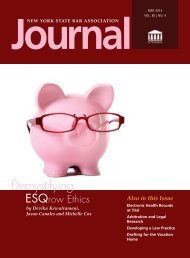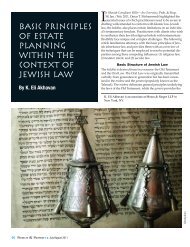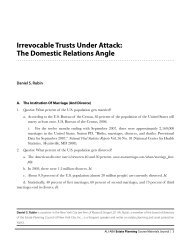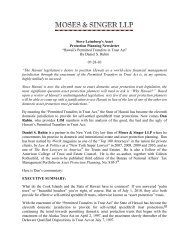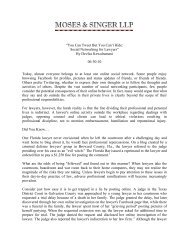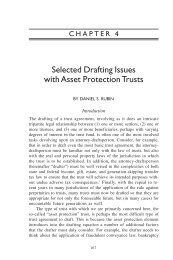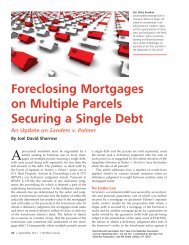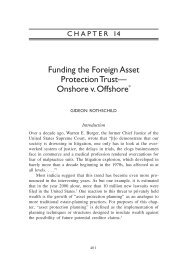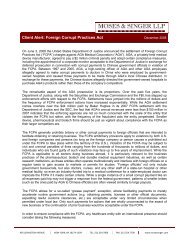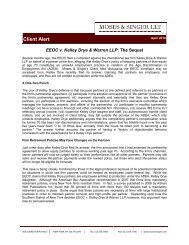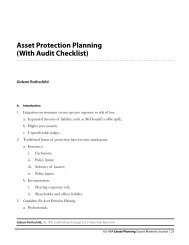Creditor Protection for Life Insurance and Annuities
Creditor Protection for Life Insurance and Annuities
Creditor Protection for Life Insurance and Annuities
Create successful ePaper yourself
Turn your PDF publications into a flip-book with our unique Google optimized e-Paper software.
I agree that this statutory exemption, perhaps like all exemptions, invites abuse. I<br />
also agree that the debtor’s relationship with the . . . trustee, her evident<br />
willingness to accept her father’s proposals, <strong>and</strong> the fact that this is a completely<br />
private arrangement are grounds <strong>for</strong> careful scrutiny. . . . I reject the argument <strong>and</strong><br />
the objections, however, because, (1) . . . the statutory exemption is not restricted<br />
to annuities provided by completely unrelated, public entities, <strong>and</strong> (2) I find no<br />
intent to defraud creditors in this debtor’s conversion of his non-exempt assets to<br />
exempt assets through the establishment of this annuity contract.<br />
In contrast, the court in In re Gefen, 41 determined that the debtor’s conversion of a non-exempt<br />
individual retirement account to an annuity with an intent to defraud creditors was a fraudulent<br />
transfer voidable under the Florida statute.<br />
Like life insurance, the exemption <strong>for</strong> the right to receive an annuity is provided under applicable<br />
federal <strong>and</strong> state law <strong>for</strong> a particular purpose; to allow persons to ensure their retirement savings<br />
through vehicles peculiarly structured to provide an income stream during retirement (i.e., the<br />
minimum distributions required <strong>for</strong> ERISA qualified plans <strong>and</strong> IRAs, or the delayed lifetime<br />
income stream provided by the traditional annuity). In the past, annuity contracts were generally<br />
held by government workers <strong>and</strong> the employees of not-<strong>for</strong>-profit institutions (<strong>for</strong> example, the<br />
Teachers’ <strong>Insurance</strong> <strong>and</strong> Annuity Association (TIAA-CREF), which is one of the country’s<br />
largest providers of annuities) <strong>for</strong> whom other retirement plans were unavailable, as well as by<br />
those retirees who chose to receive distributions from other retirement plans in the <strong>for</strong>m of an<br />
annuity rather than via a “roll-over” into an IRA. More recently however, commercial annuities<br />
(such as variable annuity contracts) are being purchased by individuals purely as a tax-favored<br />
investment vehicle without any view towards the annuity’s traditional use <strong>for</strong> retirement savings.<br />
Such products were most likely never intended to be exempt <strong>and</strong> a colorable argument can be<br />
made by creditors to the effect that such products should not be held exempt, notwithst<strong>and</strong>ing<br />
that they are, in fact, annuities.<br />
A similar issue arises when a debtor converts non-exempt assets into an exempt annuity shortly<br />
prior to bankruptcy since the purpose of such conversion is likely less to provide <strong>for</strong> retirement<br />
needs than to “avoid” creditors (although not necessarily with any noisome connotation). In In re<br />
Johnson, 42 the debtor, a physician, personally guaranteed $19 million of the obligations of a<br />
corporation of which he was a 2% share-holder. Following the corporation’s default on the<br />
obligations, judgments were entered against the debtor on his guarantees. Thereafter, on the<br />
advice of counsel, <strong>and</strong> in furtherance of what the bankruptcy court termed “bankruptcy estate<br />
planning with a vengeance,” the debtor liquidated most of his non-exempt assets <strong>and</strong> purchased,<br />
inter alia, an annuity with a face value approximating $250,000. In finding that the debtor’s<br />
specific intent to put all of his rather substantial personal wealth beyond the reach of his business<br />
creditors pursuant to the Minnesota exemption scheme did not void the exemption of the debtor’s<br />
annuity interests, the Johnson court recognized that “[t]he gut level difficulty with the case at bar<br />
stems both from the massive amounts of money involved <strong>and</strong> from debtor’s status as an affluent<br />
physician enjoying sound professional status, excellent current income, <strong>and</strong> unlimited future<br />
earning potential.” Nevertheless, the Johnson court denied the bankruptcy trustee’s motion to<br />
deny the debtor a discharge. According to the court:<br />
. . . what is truly blame-worthy about a debtor’s intentional resort to “bankruptcy<br />
9



